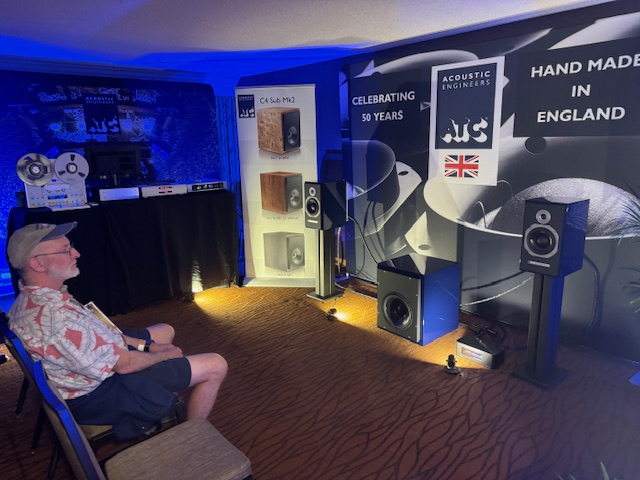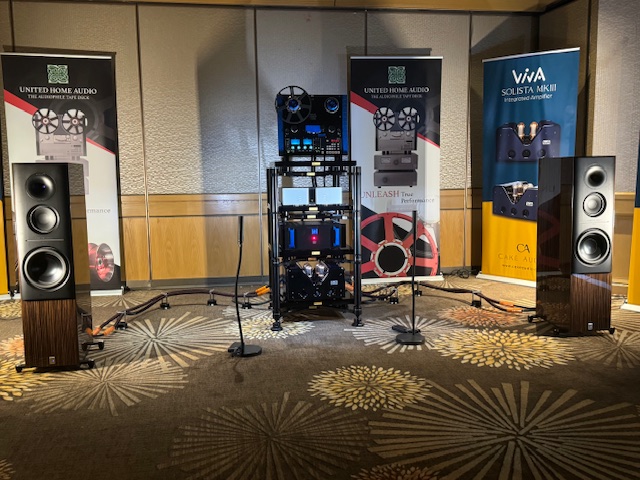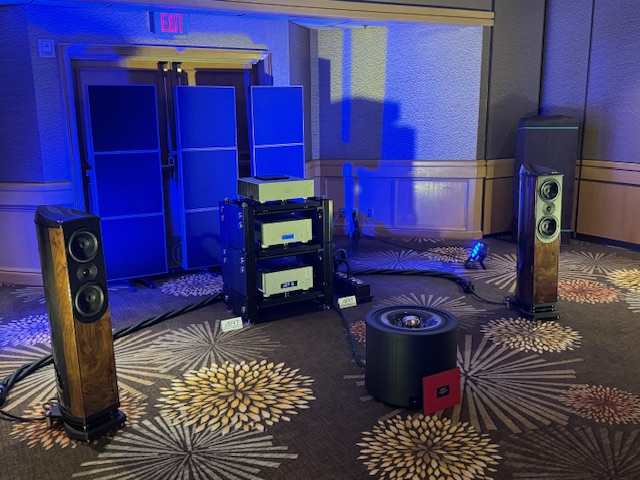It is no secret that I am a fan of many of the growing number of regional audiophile shows. Do they have their issues? Sure, they do, but where is there a better place for audiophiles to experience some of the best-sounding, most high-performance of often diverse group of components? Most of our local dealers can’t dream of offering that experience on their best day, thus it can often be worth traveling for an audiophile show, as I wrote about (read the story here) recently. We get into a lot of the advantages, but one of the best ones is that the audiophile hobby is full of cult of personality designers and equipment empresarios, and they are often waiting to meet and interact with you. They would love nothing more than the help bring their skills/products/expertise to your audiophile system in ways that you might never have dreamed possible.
But clearly, all things aren’t perfect at audiophile shows. We’ve touched on past concerns about lack of affordability of systems and overpriced gear. Many of these regional audiophiles shows don’t attract the A-List companies or products, even with dealer support. The hotels often are a little bit under the standards that one would expect for a person who could spend $20,000, $50,000 or $100,000-plus on a single audiophile product (Oligarch Audio, as we call it). There are all sorts of issues for the audiophile consumer to navigate at one of these shows, but each and every time that I bring an audiophile noob to one of these events, the same issue presents itself. That issue is how to listen at one of these events. Somewhat empty (empty of hotel furniture, at least) rooms aren’t always the best audiophile listening rooms. With doors open or even cracked, ambient noise from talking/walking people, slamming doors and/or other music playing can be twice as loud as you will find at home for your background noise. How do you overcome these handicaps? We got you, people …

Expect the Music at Audiophile Shows to Pretty Much Suck
Audiophile manufacturers tend to get inspired by the way that the establishment audiophile magazines review gear, which often means playing really obscure audiophile music (read my article on that topic, here). When asked by companies attending these events who are looking for advice, we suggest that they stick with a tight playlist of about four to five total tracks and repeat them for the entire show. We advise them to make sure that the chose demo songs are familiar and relatable, as well as well-recorded. Some legacy/classic recordings that are well-recorded are always good, as is finding newly-made recordings that have some crossover appeal, but bring the latest recording techniques to our audiophile experiences. Sadly, you won’t find this level of audiophile demo music played in most rooms, so don’t set your expectations too high if this is your first rodeo.
What can you do if you encounter a room playing some new recording of flugel horn music being played back on purple vinyl, recorded in Iceland and performed by Bjork’s cousin? If you care enough to really want to hear the equipment that somebody is playing, very politely tell the person who’s running the demonstration in the room that you would love to hear some music that you are more familiar with. If they are dicks, they will tell you to pound sand, but that is a 1/100 outcome in the worst-case scenario. Most people will ask you what YOU want to hear, and that’s when you ask for something pretty mainstream and hopefully played back in an HD format. Perhaps, in the room they have some LPs or CDs to choose from, but that’s unlikely. More often than not, you are going to get handed an iPad running Roon, Audio Nirvana, or perhaps BluOS. Each of those interfaces have a “search” button, so don’t panic. Pull up some music that you like and that you know, and rock out from there. Also, downloading a few songs in CD (or higher) quality onto your phone that are part of your “desert island” demo tracks can help. Bluetooth connections often aren’t the best-sounding, but shows are imperfect, and the sonic downside of a Bluetooth connection might be a small hurdle relative to your on-the-spot evaluation of said components/system.
Audiophile Demo Tracks Need to Be Dynamic More Than Just Loud
One of the tracks that I have used as a demo in countless reviews and even more demonstrations of ultra-high-performance audio systems is “North Dakota” from Lyle Lovett’s stunningly well-recorded Joshua Judges Ruth album from 1992. This acoustic, almost-country duet with Rickie Lee Jones sounds simply fantastic, but it is a very delicate and quiet recording and respectfully is a lousy show demo track. Why can a song be a classic at the stereo store or in my review system, but not at a show? That’s because the song is too quiet in terms of its production to be a great demo track in an environment with a lot of background noise. That means that the subtle musical elements that make such a song so fantastic to listen to at home get lost in the vast din of the background noise of the show.
So, what’s a better song choice? Something with more dynamic range would present itself better than a more open, quiet track. At the recent AXPONA show in Chicago, I went to the hallway of the hotel (which on this floor had an open atrium, which extended down a few floors) to talk with Damon Gramont from Bricasti. Even outside the demo room, there was a pretty good background noise level. Damon asked his Apple watch to check the SPLs and it was close to 80. That’s a lot of background noise.
There are countless songs that you could play that sound great, have plenty of dynamic material and are musically relatable to real-world audio consumers. Something like Marcin’s cover of Led Zeppelin’s “Kashmir” comes to mind as a new-school, audiophile instant classic. The melody is familiar. Marcin and his bass player bring an EDM groove to a Zeppelin tune, while he brings one part acoustic Eddie Van Halen tapping technique and another part beat-on-your-acoustic-guitar style that brings actual (somewhat odd, but it totally works) percussion to the song. Overall, the Marcin track is louder and less delicate. It has the power to cut through the in-room conversations with enough volume and musical dynamics that you can actually hear what the system is doing and how it is sounding.
There are likely millions of songs that shouldn’t be played at an audiophile show for various valid reasons. The good news is that there are more than enough great songs that have the ability to cut through the din of the show floor, so that it is easy to make a great show demo.
Resetting Manufacturers/Dealer Expectations When Listening at an Audiophile Show
One of the biggest demographics at any audiophile show is the older guy who is there to listen to new expensive audio so that he and his buddies can say “my system is better.” To be clear, these guys buy literally nothing. To call them tire-kickers is simply too kind, nor can you likely impress them. Many, including myself, have suggested that the audiophile hobby for a lot of the OG audiophiles is more an exercise in religion and a commentary on hearing loss than anything. These guys cobble together an audiophile system that is filled with used gear that sounds good to their ears and in their rooms. That’s cool if they get the results that they want from their systems, but for a dealer or a manufacturer working with a local dealer at a show, these people can’t even be considered leads.
The costs of attending these audiophile shows are going up, up and up in the current economy. You already know how expensive travel is now, post-pandemic. More and more hotels don’t even want to host events like audiophile shows, because they are a) rough on the physical properties with all of the furniture moving and whatnot, and b) they can sell nearly all of the rooms at some rate via online hotel/travel sites without moving one LED TV or nightstand. Because of this, they charge more to the exhibitor, thus making the show more and more expensive. Then there is staffing a show. That’s very expensive, too, and where local dealers often help. How many times can you expect the owner, designer or president of the company to come to an audiophile show somewhere in the country, when there is an event nearly monthly during the year? They can’t do them all in terms of cost, logistics and sheer human will.
In terms of manufacturer/exhibitor expectations, they need to understand that the money spent on attending a show might “plant seeds” for future sales at best. They might help a local dealer fill his sales opportunity pipeline with some new people, and that dealer likely will be loyal to you for such an act. At the same time, that long-term benefit doesn’t pay the solidly five-figure costs to attend a hotel-room-based audiophile show. Those spending to go to these shows need to have the money to invest in intangible benefits over the long term. And lastly, it is OK to sell the show demos off, but it is NOT OK (unless you want to devalue your gear’s asking price) to offer every person that comes in the room a show demo price of dealer cost (40 to 50 percent off) on the show demos. A better solution is to put a sign on the components for sale, saying “Ask about show demo specials,” so that you can move some equipment and save money/time/logistics on shipping and open-box inventory. That’s a more elegant solution to an awkward audiophile show situation that I see far more often than I should.

Setting Consumer Expectations for Listening at an Audiophile Show
Audiophile shows are great for hearing all sorts of different components, systems and overall audiophile configurations. What they aren’t good at is presenting you the entire, perfect sonic picture of what a component or audiophile system can do. Why? Because the listening environments are simply flawed. Fatally flawed? No, but the way that consumers should look at consumer audiophile shows is that of a salesman doing prospecting. Could this audio component do it for me? Maybe … Perhaps it is worth working with a local dealer for an in-store or even in-home demo? That’s a very reasonable progression from experiencing something cool at an audiophile show.
For the record, if you are serious about making a purchase sometime soon, it is totally cool to ask for a private show demo. In the press, we sometimes will ask for an after-hours demo if we want to get a little more serious about listening to a component. Rarely if ever do I do this, but it is an option, and can be an option at a show. Most audiophile shows end at around 6 PM in the evening. If you ask nicely, you might be able to get 20 to 30 minutes of closed-door listening that might help you narrow down your options for your next audio upgrade. Please only ask for this level of accommodation if you are a serious buyer doing real-world research, as the people who run these rooms are ultra-tired by the end of the day. As much as they want a tasty drink and a fine, sit-down dinner, they want to sell you audio gear even more, thus why they will almost always take good care of you if you are close to making a decision on buying their gear.

Final Thoughts on Listening at Audiophile Consumer Shows …
When you set your expectations in the right ballpark, the benefits of going to an audiophile show can be big. Yes, the listening is anything but perfect, but you can experience all sorts of different setups that can expose you to new products, configurations and technologies that you might never experience at your local AV store. These leads can point you on the path to your next meaningful upgrade, or just remind you why your system is as good as it is in its current configuration.
The key concept here is to not get flustered by the people, the noise and the often-goofy music being played at these shows. They present a start to a conversation, but rarely an ending, which is totally OK. The real fun is meeting the people behind the gear and learning how the sausage is made. Sometimes, you stumble upon products and concepts that you may have never considered before. Other times, you make friends with the people behind these companies, which lead to lifelong friendships and/or business relationships. In the end, the community is the driving force behind these shows, but the potential benefits, when expectations are set correctly, can be gigantic.
What audiophile shows have you been to? How do you deal with the background noise, seating issues and other logistical issues? Do you go to audiophile shows looking to buy or do research that would lead towards a purchase, or are you going just to listen to a bunch of different gear? Let us know how you attend said shows in the comments below. We ALWAYS LOVE to hear from you.




I live in a neighboring state so have been to Axpona several times. Mainly I love audio gear and the show is like the proverbial candy store. A few times I have used the visit to explore a next purchase. In one instance I remember planning to buy a music server, I visited at least three of the main companies but only one had exactly what I was looking for.
Many companies are starting to use treatments in the rooms which helps with sound quality. Most try to keep the door closed to keep out the noise from outside but there’s always someone talking to a friend or in and out traffic noise. Typically I’ve found seating to rotate fairly well and most folks are polite.
If someone is into audio I highly recommend the experience. I think that’s why we are seeing the audio shows grow so much.
AXPONA is better than Munich (which moving to Vienna????) in many ways and close by.
I need to spend BIGLY (if I use another Trump word – stop reading my publication in protest, please) to go to both. If you play you cards right, you can get a Dreamliner or 777 to Chicago and back from LA. A short flight for a lie-flat seat but I like it.
Munich cost me $3,750 with a connection in Frankfurt for business class. I am seeing the same basic price via Scandinavian Airlines through Copenhagen and a little more on Turkish Air via Istambul (never been there). Turkish is hard to work with in terms of support.
Needless to say – the shows are AWESOME if you want to hear a lot of audio in one place. We all can build our audiophile experiences and become better consumers/enthusitasts/reviewers etc…
Jerry
The key to AXPONA every year is knowing what you want out of it. Looking for new things? Read the room list prior in great detail! Knowing who is where on what floor is huge in saving time and disappointment when you miss one. Pick your favorites and make a floor list and stick to it, top to bottom floors is the best approach. Less distractions.
Looking to turn on friends to the experience? Be prepared to do what they want to do, not you. I brought 3 friends last year and it meant their experience, not mine (despite still wanting to see key rooms I missed). But given I had 2 visually impaired listeners brought into the fray for the first time meant a different kind of experience for me. It also meant free beer at 5pm for Metal Hour in one of the demo rooms! Make sure your expectations fit your prep.
Buying equipment? Never trade in 2 subwoofers into the dealer that’s also has a huge booth on the ground floor. Even with your car parked right outside in the loading zone and flexed muscles, your time will be exhausting and leave you looking like an over-steamed clam. (I missed Michael Fremer’s demo that way.)
If you are looking to move to a proper demo position in any given room, get some class! Sit back in the back seats and let others sit for 2-3 songs and several chair changes before it’s your turn. Don’t prove to everyone that civilization is in entropy! I actually had one woman save her prime seat next to her for her purse! Not classy. Fortunately, a blind friend wanting to hear more is the perfect privilege killer!
Getting an early parking spot can mean a home base for materials and smoking breaks, instead of an expensive hotel room (for locals, at least). I’m from Milwaukee and going to Schaumberg is a hop skip and a jump. The last 3 years in Chicago have been LA beautiful! 2025 can’t miss!